
Introduction
Structured data is a way of structuring your webpage content by using schema markup vocabulary that is acceptable by all major search engines. Markup vocabulary is a piece of words that sits inside your webpage code that gives the search engines additional information about your page.This markup will help search engines to understand your content in a better way which eventually leads to rich results in SERP.If your data is not structured then it will become a little difficult for a search engine to understand what is your content all about.It will not directly help you to rank higher on google but structure data has its benefits and importance.One of the benefits of structured data is to get rich results formerly known as “rich card” or “rich snippet”.Confused yet? Let’s try an example because structured data really drives me off and probably it does to you too.Here is the post on our website “How to write a Blog Post” As a human, we can understand that this is an article on the topic of How to write a Blog Post.You can easily recognize the title name, who wrote this, and the published date of the article without any difficulty, right?We can relate things with just an image as shown above but Google cannot make connections on their own, as we humans can do.So, this is what structured data do which search engines can understand without any struggle.And, you will get an advantage of SEO if your website is easily understandable by the search engines.
As a human, we can understand that this is an article on the topic of How to write a Blog Post.You can easily recognize the title name, who wrote this, and the published date of the article without any difficulty, right?We can relate things with just an image as shown above but Google cannot make connections on their own, as we humans can do.So, this is what structured data do which search engines can understand without any struggle.And, you will get an advantage of SEO if your website is easily understandable by the search engines.
What is Schema.org in Structured Data?
For organizing something, rules are necessary, same goes with structured data. If you want to make Structured data you need to take help from schema.org. Schema.org is a form of microdata or semantic tags that are used to improve the way search engines represent and read your page by adding it to the HTML.To develop the Structured Data protocol schema.org has two groups first is the Steering Group and the second one is the Larger Community Group.The entire process is managed by the smaller group, The Steering Group, and the main work of creating, discussing, updating, or proposing is done by The Community Group.When you give structure to your content by adding schema markup you help search engines. For example if you have published an article then you can add article type markup on your page that includes article [title], [Author name] is the author of the article, and it was published on [website link].With the Schema glossary, you can mark up specific bits of content on a webpage, there are thousands of schema terms and it is impossible to memorize all of that but you don’t need to remember anything about schema markup to use it on your site.Search engines support structured data in JSON-LD, Microdata, and RDFa format and they prefer JSON-LD format because it is easy to implement.That might look tricky but stay with me. I’II explain to you later in this article.
Schema.org is a form of microdata or semantic tags that are used to improve the way search engines represent and read your page by adding it to the HTML.To develop the Structured Data protocol schema.org has two groups first is the Steering Group and the second one is the Larger Community Group.The entire process is managed by the smaller group, The Steering Group, and the main work of creating, discussing, updating, or proposing is done by The Community Group.When you give structure to your content by adding schema markup you help search engines. For example if you have published an article then you can add article type markup on your page that includes article [title], [Author name] is the author of the article, and it was published on [website link].With the Schema glossary, you can mark up specific bits of content on a webpage, there are thousands of schema terms and it is impossible to memorize all of that but you don’t need to remember anything about schema markup to use it on your site.Search engines support structured data in JSON-LD, Microdata, and RDFa format and they prefer JSON-LD format because it is easy to implement.That might look tricky but stay with me. I’II explain to you later in this article.
What Are Rich Results?
Rich results are enhanced results shown in Google SERP that are different from normal blue link results. Rich results can include carousels, images, reviews or ratings, etcTo better understand the meaning of rich results, look at the image below. This is a regular search result, It contains only meta description, publishing date, and title. Now you can compare regular search with the rich results displayed below:
Now you can compare regular search with the rich results displayed below: These results appear on the same search result page, just before the organic results. First, there is the recipe carousel that includes a few recipe cards. Then, there is a rich results with an image, star ratings, and the expected preparation time.Rich results are designed to highlight key information and help search engines understand the purpose of the page to show best possible results for certain queries.
These results appear on the same search result page, just before the organic results. First, there is the recipe carousel that includes a few recipe cards. Then, there is a rich results with an image, star ratings, and the expected preparation time.Rich results are designed to highlight key information and help search engines understand the purpose of the page to show best possible results for certain queries.
Different Types of Schema Markups
Schema markup vocabulary includes different formats for structuring data framing all kinds of places, things, and people.For the full list, you can go through the schema.org website. Schema markups are commonly used to indicate different things like:
- Recipes
- Reviews
- Events
- Article
- Products
- Organizations
- Local Businesses
For the making of most of the rich results for your site, you will need to tag up your website with these important markups:
- Sequential Carousels
- Breadcrumb Navigation
- Corporate Logos
- Contact Information
Here are few frequently used tags for individual content types:
- Events
- Big Data Sets
- Training Course
- Jobs And Occupation
- Local Business Details
- Fast Check Information
- Books
- News
- Blog Articles
But the other fact that you need to keep in mind is that search engines do not always create rich results for your web page, But it would be a great practice always markup your content with with schema markup.Let’s look at the example of the review rich results :
What Are the Benefits of Rich Results?
Rich results appear at the top of the results page, often in the position zero above traditional organic results.They’re also presented in boxes, which make them easy to click for users and more useful than traditional results. These boxes can have a carousel design that allows users to swipe through answers for more information.They increase the possibility of increased click-through-rate to your site and higher CTR is one of the important ranking factors.By optimizing the website to appear in search results will also boost your ranking and traffic.By using the partial answer or additional information to get users clicking through to your website. For better clarity look at the below image: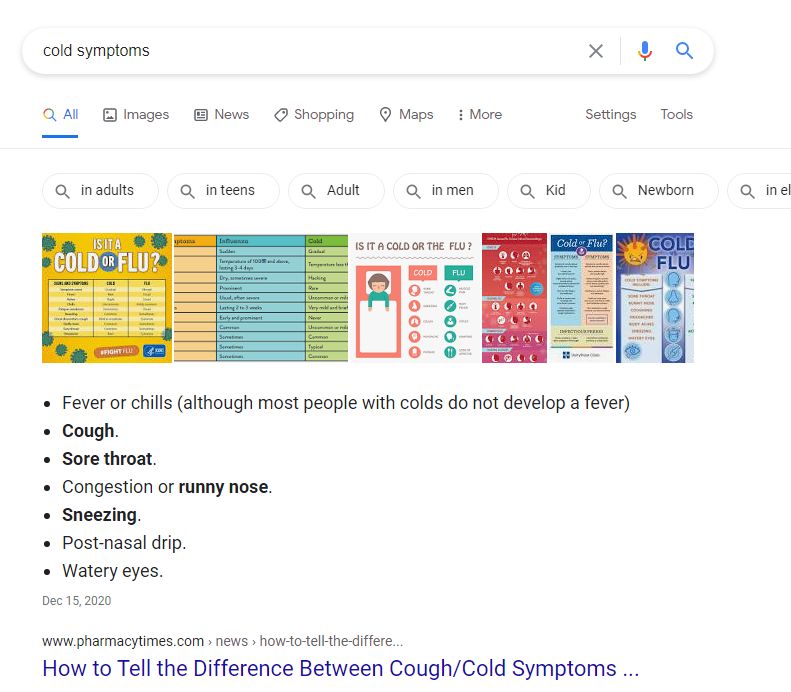 You have to create the content in a format that search engines understand or prefer and make sure the content you’ve created matches what is currently ranking.
You have to create the content in a format that search engines understand or prefer and make sure the content you’ve created matches what is currently ranking. Reviews and star rating are the keys to building trust which ultimately helps your product and business. So you need to have genuine and positive reviews with a testimonial from a satisfied customer.
Reviews and star rating are the keys to building trust which ultimately helps your product and business. So you need to have genuine and positive reviews with a testimonial from a satisfied customer.
How to Add Structured Data to Your Website
Here I’ll explain to you step by step how you can implement structured data on your website from the very beginning to the end.You be feel that all of this requires in-depth technical understanding but it’s not like that Google made this process very easy so that more and more people can easily implement structured data on their website
Structured Data Markup Helper Tool
First of all, you need to open up a structured data markup helper. This is a great tool provided by Google itself.
Select a Data Type
Then you need to select the data type to start the process, then paste the URL or HTML source code of the page that you want to structure below the box.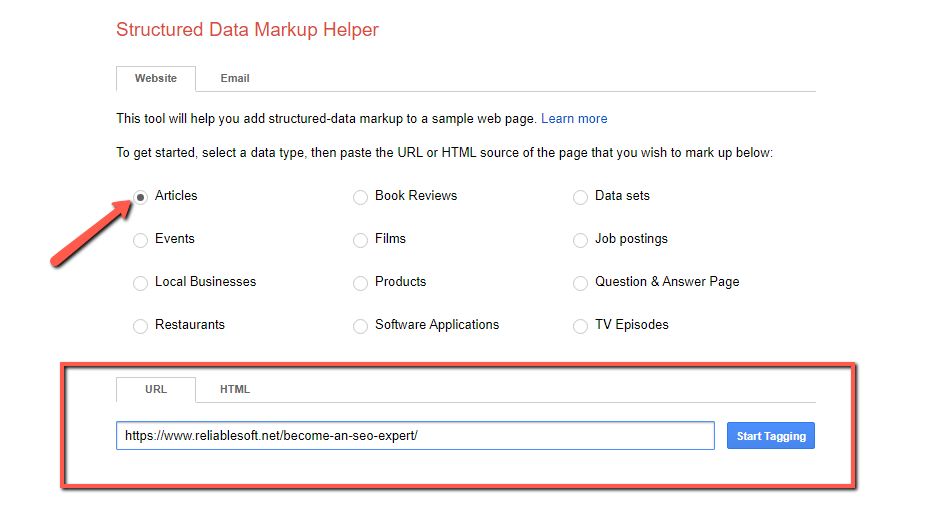 Here in this example I selected the article as a type and added my webpage URL.
Here in this example I selected the article as a type and added my webpage URL.
Start Marking up Your Webpage
After the URL submission Google will load your web page inside the window for there you just need to select the items on your webpage that you want to markup.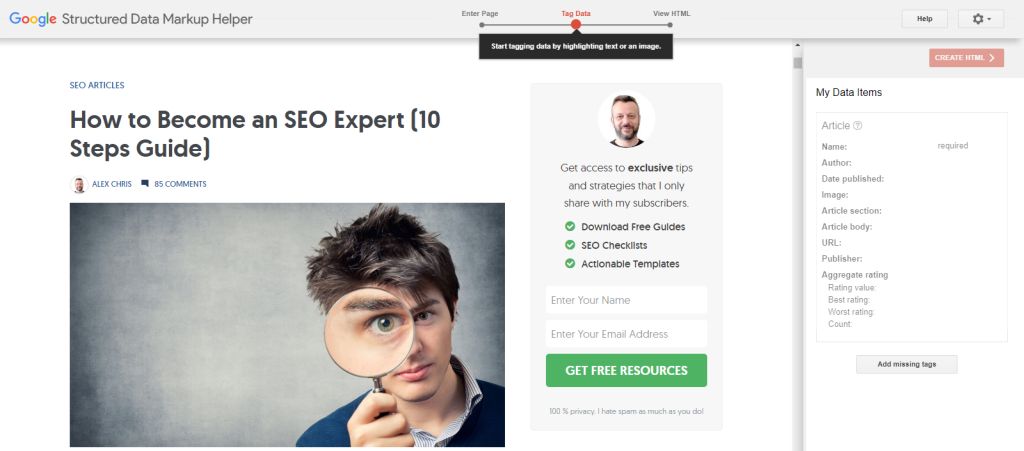 When you click on the items like the heading of your article this tool will show you all the available options, so choose the appropriate option. Here I have selected the name option for the heading item.
When you click on the items like the heading of your article this tool will show you all the available options, so choose the appropriate option. Here I have selected the name option for the heading item. Now you can see it’s added on the right sidebar, You can see all the marked items in the right section named as my data items.
Now you can see it’s added on the right sidebar, You can see all the marked items in the right section named as my data items. Here in this example I marked up this webpage with Name, Author, and Image items. These are just a few examples, but you can add more than that by selecting add missing tags in the right sidebar.
Here in this example I marked up this webpage with Name, Author, and Image items. These are just a few examples, but you can add more than that by selecting add missing tags in the right sidebar.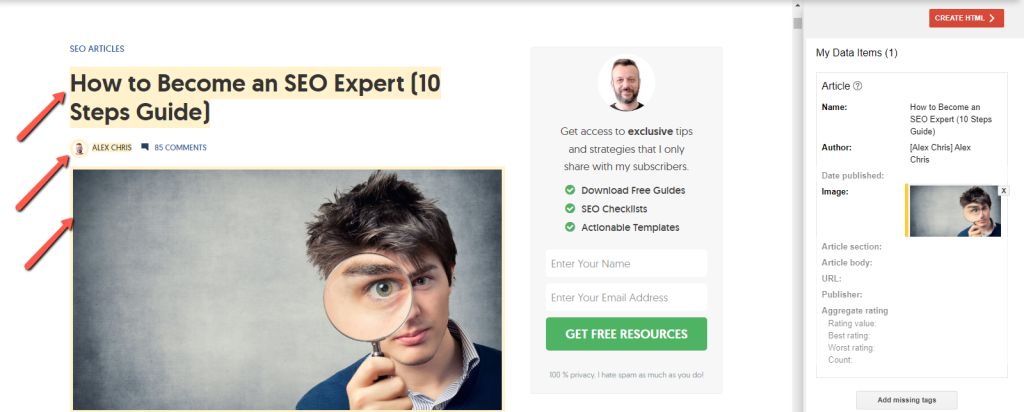
Download the HTML
Now click on create HTML button to get the snippet of your code that you can easily add to your webpage.On the next page you’ll see the code that is by default is in JSON-LD format but you can change it into microdata as well by clicking on the dropdown button. But I’ll suggest you to keep it in JASON-LD format.This is how your final code will look like:
Test Your Markup With Google’s Structured Data Testing Tool.
For testing the markup code you need to copy and paste it into this tool and it will show you errors and warnings. According to recommendations, you can further optimize your code.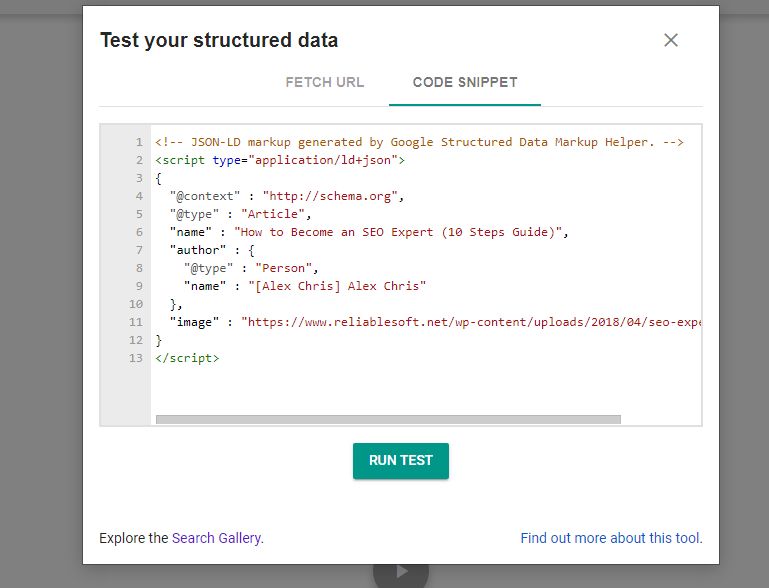
Publish Your Markup on Your Webpage
The final step is to publish your markup, for that you just need to copy and paste the new HTML markup into your CMS or source code of your web page.
What’s the Difference Between a Rich Snippet and a Featured Snippet?
Feature snippet is an answer to a query the result which appears above organic search results and the rich snippet is an enhanced organic search result.Feature snippets are shown based on the structure of your webpage that is done by assigning heading HTML tags.Example of feature snippet: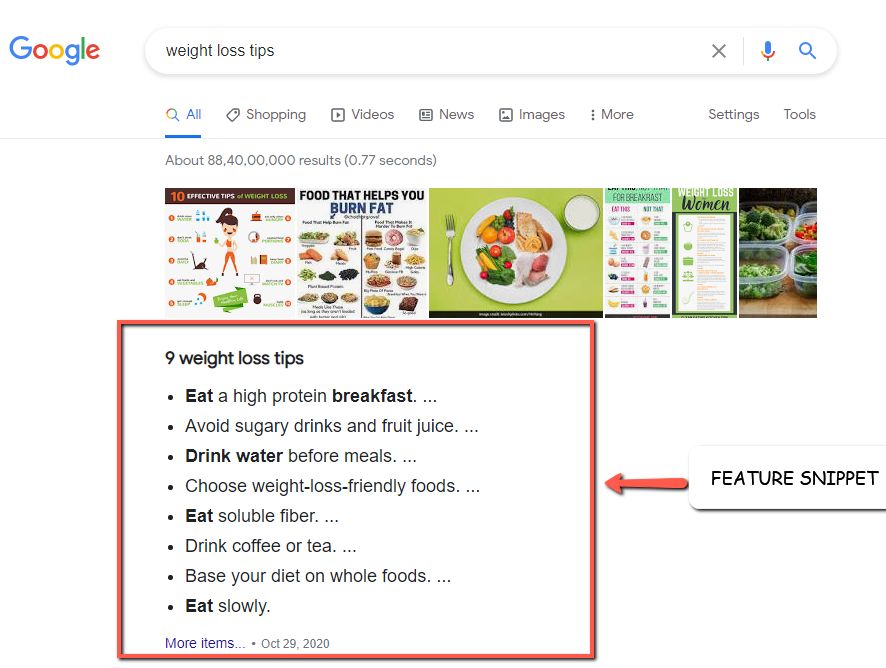 When the search engines fully understand your structured data then it appears as a rich snippet and that is achieved by adding schema markup to your web page.Example of rich results:
When the search engines fully understand your structured data then it appears as a rich snippet and that is achieved by adding schema markup to your web page.Example of rich results: Search engines are constantly improving their ability to understand your content and when you use structured data on your website you are helping search engines to understand what is your content so that information can be displayed in search results.
Search engines are constantly improving their ability to understand your content and when you use structured data on your website you are helping search engines to understand what is your content so that information can be displayed in search results.
What is Knowledge Graphs
Few people are still confused about knowledge graphs and rich results. The knowledge graph is a database of Google that collects millions of pieces of data about keywords people frequently search for on the internet and try to interpret the intent behind those keywords, based on the already available content.Look at the below image for a better understanding of the knowledge graph: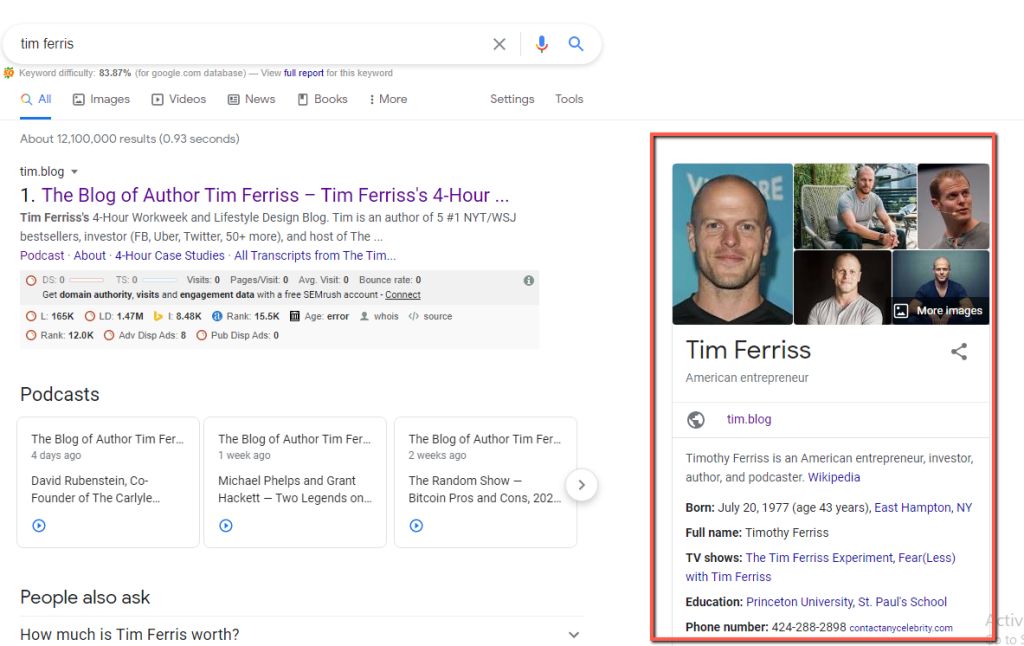 Usually, a knowledge graph shows information about people, facts, and places that are interconnected in one way or the other. And it is shown based on evaluating schema markup of your page.
Usually, a knowledge graph shows information about people, facts, and places that are interconnected in one way or the other. And it is shown based on evaluating schema markup of your page.
Why Do We Need Structured Data in SEO?
Structured data helps your content to display in search engines in an enlarged way. Improved search results are attractive and obviously, it will improve more clicks. When you use structured data then you don’t have to rely on an AI’s interpretation of your site info.When People start to land on your page, you need to give them high quality and updated content. If they find your site useful and gain some information they will stay longer on your site and come back if they want to gain some information.Structured data also changes your search results look. It will show more specific information to your reader. And this will improve the possibility of a customer clicking on your results.When people come again and again to your website it will also help you to rank higher on the Search Engine Results Page.
Top reasons why some brands don’t use schema:
- They don’t know the benefits of using it.
- They are unaware and stuck in the past
- They don’t have any resources.
- Not technical enough to understand the code and how to mark items up.
Does Structured Data Work on Mobile?
Yes, the results of executing structured data work everywhere. Mobile is one of the places where the results of a Schema implementation are most noticeable.If a page meets Google’s guidelines, you can book movie tickets or a table at a restaurant directly from the search results.If you implement structured data correctly, you could also be qualified for several interactive extras in the mobile search results pages.
Structured Data and Google AMP
Google launched the Accelerated Mobile Pages open-source project to ensure that mobile webpages operate at optimal speed.It is developed to achieve a specific goal of allowing web pages and ads to load consistently fast across all devices.According to Google AMP pages that have structured data can appear in a carousel of stories in search results. Without structured data, AMP pages may only appear as standard blue links in Google Search results.
Does Schema Help You to Rank Better?
Most digital marketing companies consider schema markup as the most powerful SEO tool. Although, it is not used as frequently.You might don’t see a direct impact on ranking as a result of adding schema but you could see more traffic from search.
Ways of Implementing Structured Data
These are the codes that can be added to HTML, XHTML, and XML-based documents to embed metadata on the web.Google Search Engines support three main formats of structured data that you can use on the web:
- JSON-LD (Javascript Object Notation for Linked Objects)
- Microdata
- RDFa (Resource Descriptive Framework in Attributes)

Source: Understand how structured data works
1. JSON-LD
JSON-LD is a mark-up language and stands for “Javascript Object Notation for Linked Objects” Google recommends using JSON-LD for structured data wherever possible. You can go through the google description.It automatically adds the required Schema bits to your site.This JSON-LD based data format makes it much easier to add structured data since it creates a block of code and is no longer embedded in the HTML of your webpage.That means that it is easier to write and maintain, plus both humans and Google can understand it better.Here is an example using JSON-LD: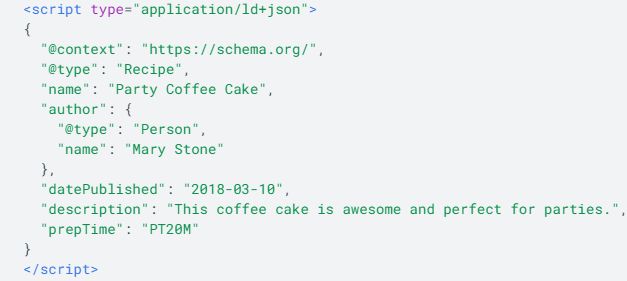
2. Microdata
In microdata, we use an additional tag to the HTML on our webpages for describing search engines that this is specific information.By doing this you are helping search engines to better understand.For better understanding you can see the below example:Itemprop is used to indicate that the containing tag has the value of a specified item property itemid is used to indicate a unique identifier of the item. item scope create the item which indicates that the rest of the element contains information about itThis is good for simple markup like this but will become difficult to manage for complex applications.
item scope create the item which indicates that the rest of the element contains information about itThis is good for simple markup like this but will become difficult to manage for complex applications.
3. RDFa
RDFa stands for “Resource Descriptive Framework in Attributes”.RDFa works the same as microdata. In this, you have to markup HTML elements on the page.These are the least used schema syntax.Different types of RDFa’s attributes:About is used to specify the resource the metadata is about,rel and rev is used to specify a relationship and reverse relationship with another resource.Src, href, and resource is used to specify a partner resource.Here is an example of RDFa:
Structured Data Testing Tools
There are a lot of Structured Data Testing Tools I am listing some free Structured Data Testing Tools.
| Structured Data Testing Tool | Price | Features |
| Google’s Structured Data Testing Tool | Free | Validates basic structured data test by pasting URL or code snippet |
| Structured Data Linter | Free | Presents a visible preview of the code vocabulary test for Schema.org, Facebook’s Open Graph, SIOC, and Data-Vocabulary.org |
| JSON-LD Playground | Free | Complete analysis of JSON-LD 1.0 and 1.1 formats various output formatting – Expanded, Compact, Table, Visualized, Framed |
| RDF Translator | Free | Supports a broad range of structured data format test by pasting URL or code snippet |
Importance Of Structured Data for Semantic Search
Semantic means the meaning of something and “Semantic Search” means to improve the search accuracy by understanding a searcher’s intent through contextual meaning.Semantic search will give you an enhanced understanding of searcher intent. Semantic search is used to optimize a page for search by covering an entire topic, rather than a single word.Adding structured data to your long-form content gives the search engine better context about the content on the page means the more Google can work on a semantic level better results it can show for your target keywords.Two Primary Factors That Guide Semantic Search Are:Search intent- search intent is the cause behind the search query on the search engine, by considering the intent of users, engines can provide more related results.(e.g a product page. a brand’s site, etc.)Semantic meaning- Semantics is the study of meaning and relationships of words. Semantics relates to the relationships between a search query, related words and phrases.
Guidelines for Structured Data Implementation
Don’t use structured data unnecessary. Use where it is relevant to your content. Sad to say that but few people often misuse this strategy.If you are not going to follow this, it may lead you to receive aspammy data manual action from Google. In structured data, things may change with time so make sure you have updated structured data.You can take real life examples from Medicines they come with an expiry date.
Conclusion:
In a nutshell Structured data is very important for your website SEO, I agree that It requires some technical understanding but it is worth it to learn.

I have good SEO experience working with different companies and clients on a long term basis. Currently, I am working as a marketing manager at Incrementors web solutions. I enjoy creating and implementing new marketing strategies as well as utilizing social media. Apart from that, I love to spend time with children and books, that’s what makes me feel alive.
Linkedin Profile: https://www.linkedin.com/in/brack-nelson/
Twitter Profile: https://twitter.com/BrackNelson